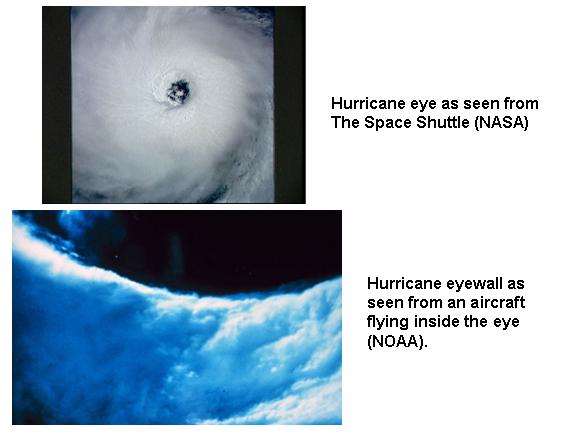
|
What causes hurricanes?
|
Hurricanes are intense low pressure
areas that form over warm ocean waters
in the summer and early fall. Their source of energy is water vapor
which is evaporated
from the ocean surface.
Water vapor is the "fuel" for the hurricanes because it releases the
"latent heat of
condensation" when it condenses to form clouds and rain,
warming the surrounding air.
(This heat energy was absorbed by the water vapor when it was evaporated from the warm
ocean surface, cooling the ocean in the process.)
Usually, the heat released in this way
in tropical thunderstorms is carried away by wind shear,
which blows the top off the thunderstorms. But when there is little wind shear, this heat can
build up, causing low pressure to form. The low pressure causes
wind to begin to spiral inward
toward the center of the low.
These winds help to evaporate even more
water vapor from the ocean, spiraling inward toward the center, feeding
more showers and thunderstorms, and warming the upper atmosphere still more. The showers
and thunderstorms where all of this energy is released are usually organized into bands (sometimes
called "rainbands" or "feeder bands"), as well as into an "eyewall" encircling the center of the storm.
The eyewall is where the strongest winds occur, which encircle
the warmest air, in the eye of the hurricane. This warmth in the eye is produced by sinking air, which
sinks in response to rising air in the thunderstorms. The winds diminish rapidly moving from the
eyewall to the inside of the relatively cloud-free eye, where calm winds can exist.
|

|
| Hurricane intensity is based upon the highest sustained (1 minute average) wind speed the hurricane is
producing. The "Saffir-Simpson" scale rates hurricane strength in this way from Category 1 to Category 5.
These categories were chosen based upon the amount of damage that each category can produce.
|
| Intensity | Wind Speed | Damage |
| Category 1 | 74- 95 mph | MINIMAL: tree branches, shrubs, unanchored mobile homes |
| Category 2 | 96-110 mph | MODERATE: mobile homes, poorly constructed buildings, some trees down |
| Category 3 | 111-130 mph | EXTENSIVE: small buildings damaged, large trees down, mobile homes destroyed |
| Category 4 | 131-155 mph | EXTREME: outer walls damaged, roof failure on small buildings, extensive damage to doors and windows, mobile homes destroyed |
| Category 5 | >155 mph | CATASTROPHIC: complete roof failure on many buildings, some buildings destroyed, severe window and door damage, mobile homes destroyed |
|
In low-lying areas, much of the damage from hurricanes can be from the "storm surge", in
which water being blown onshore by the high winds rises rapidly. The storm surge can destroy the lower floors
of some buildings, or even destroy the foundations of residences causing the homes to wash away.
The storm surge can also trap residents from evacuating along low-lying escape routes.
Hurricanes almost always travel poleward at the end of their life cycle, helping to transport excess heat out of the tropics toward
higher latitudes. Sometimes the hurricane will merge with an extratropical (non-tropical) storm system, which can cause temporary intensification of the storm, as
was the case with Hurricane Sandy which hit New England in late October, 2012.
Hurricanes gradually die as they move over cooler waters, which do not have the heat
energy necessary to evaporate sufficent water vapor into the atmosphere to fuel the hurricane. If
the hurricane crosses over to land, the heat source is removed entirely. With the
removal of the energy source, and the greater surface friction of the land's terrain and vegetation, the hurricane's winds rapidly decrease.
|
|
(page last updated 12/14/2019)
|




